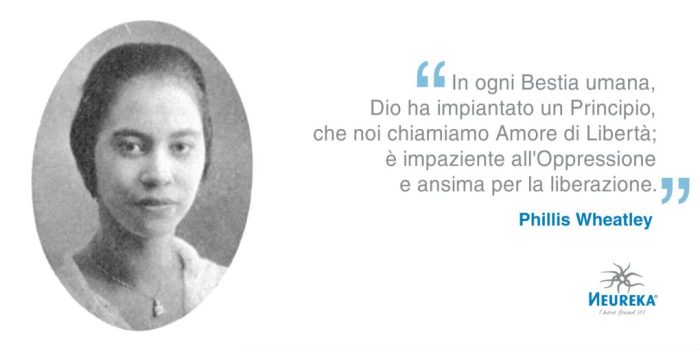To kill a mockingbird prejudice quotes – To Kill a Mockingbird, a timeless classic by Harper Lee, offers a profound exploration of racial prejudice and social inequality through a collection of powerful quotes. These quotes illuminate the complexities of human nature, challenge societal norms, and provide invaluable insights into the enduring struggle for justice and equality.
From the poignant reflections of Atticus Finch to the heartbreaking experiences of Tom Robinson, To Kill a Mockingbird presents a tapestry of voices that expose the insidious nature of prejudice and the devastating consequences it inflicts upon individuals and communities.
Racial Prejudice
To Kill a Mockingbirdexplores the pervasive nature of racial prejudice in the American South during the 1930s. The novel demonstrates the devastating consequences of racism on both individuals and society as a whole.
Examples of Racial Prejudice in the Novel
- The trial of Tom Robinson, an innocent black man accused of raping a white woman, highlights the deep-seated prejudice against African Americans in Maycomb.
- The Finch family faces ostracism from the community for defending Tom Robinson, demonstrating the social consequences of challenging racial norms.
- The use of racial slurs and derogatory language throughout the novel reflects the casual and ingrained racism of the time.
Consequences of Racial Prejudice in the Novel
- The conviction of Tom Robinson despite his innocence exposes the flawed justice system that perpetuates racial inequality.
- The ostracism of the Finch family isolates them from the community, highlighting the social divisions caused by prejudice.
- The perpetuation of racial stereotypes and hatred leads to violence and injustice, as seen in the lynching of Tom Robinson.
Social Inequality: To Kill A Mockingbird Prejudice Quotes
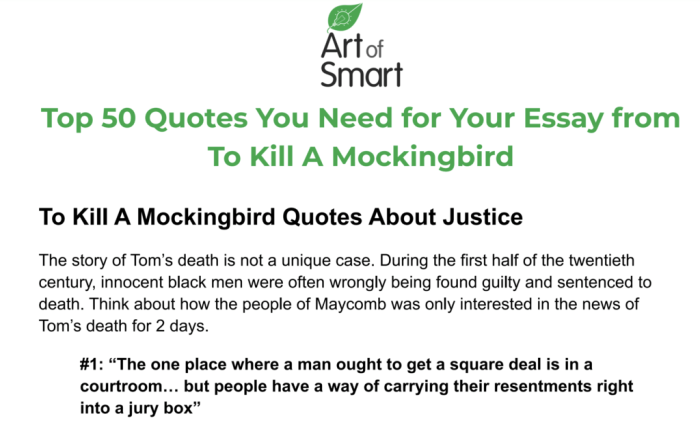
The novel also examines the social inequality prevalent in Maycomb. The social hierarchy based on race, class, and gender shapes the lives of the characters.
Examples of Social Inequality in the Novel
- The Finch family’s social status as wealthy landowners places them at the top of the social hierarchy.
- The Cunninghams, a poor white family, face discrimination and are often treated as inferior.
- African Americans, such as Calpurnia and Tom Robinson, are relegated to the lowest social status and denied basic rights.
Consequences of Social Inequality in the Novel
- The social hierarchy creates barriers to opportunity and limits the potential of individuals based on their social class.
- The prejudice and discrimination faced by African Americans reinforces their marginalized status and perpetuates a cycle of poverty and oppression.
- The social divisions within Maycomb contribute to the conflict and tension that drives the plot.
Moral Development
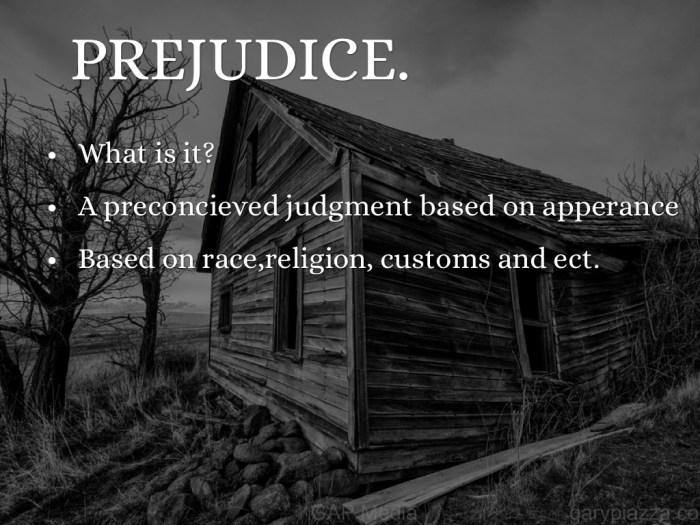
To Kill a Mockingbirdfollows the moral development of Scout Finch as she navigates the complex world of racial prejudice and social inequality.
Examples of Moral Development in the Novel
- Scout’s initial acceptance of the racial norms of Maycomb is challenged as she witnesses the injustice of Tom Robinson’s trial.
- Her father, Atticus Finch, serves as a moral compass, guiding her to understand the importance of empathy and justice.
- Scout’s growing compassion and understanding lead her to challenge the prejudices of her community and stand up for what is right.
Challenges to Moral Development in the Novel, To kill a mockingbird prejudice quotes
- The pervasive racism and social inequality in Maycomb make it difficult for Scout to fully comprehend the injustice she witnesses.
- The pressure to conform to social norms can stifle moral development and prevent individuals from speaking out against injustice.
- The complexities of human nature and the influence of societal conditioning can make moral decision-making challenging.
The Power of Language
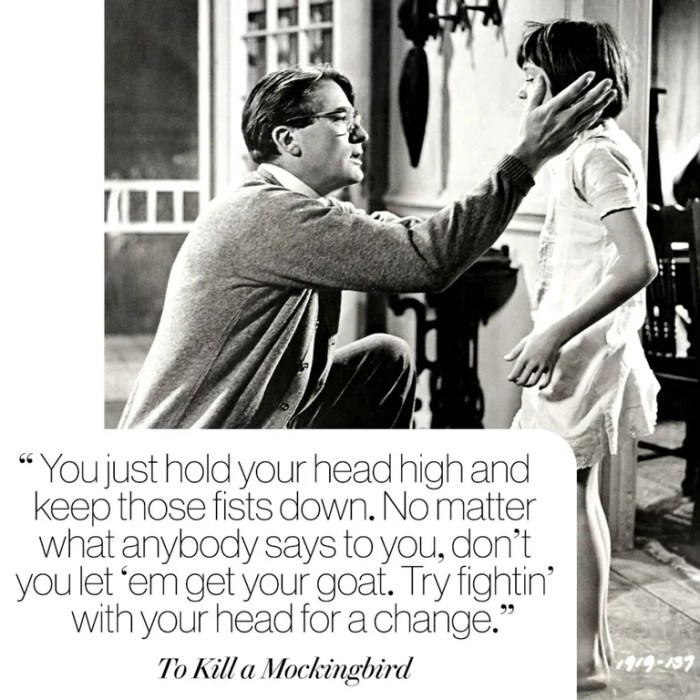
The novel explores the power of language to both harm and heal. The characters’ words and actions shape the events of the plot and reveal their own prejudices and values.
Examples of the Power of Language in the Novel
- The use of racial slurs and derogatory language perpetuates racism and dehumanizes African Americans.
- Atticus Finch’s courtroom speeches use language to defend the innocent and challenge racial prejudice.
- Scout’s innocence and perspective allow her to use language to question the established norms of her society.
Limitations of Language in the Novel
- Language can be used to deceive and manipulate, as seen in Bob Ewell’s false accusations against Tom Robinson.
- The limitations of language make it difficult to fully express the complexities of human experience and emotion.
- Language can be used to justify prejudice and discrimination, as seen in the arguments of the white community against Tom Robinson.
Symbolism
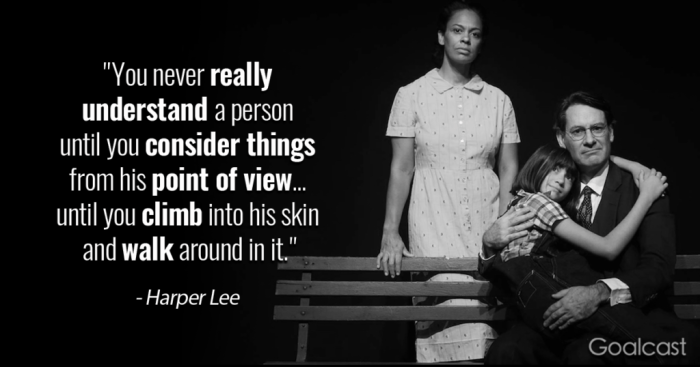
To Kill a Mockingbirduses symbolism to convey deeper meanings and themes throughout the novel.
Examples of Symbolism in the Novel
- The mockingbird represents innocence and the importance of protecting those who are vulnerable.
- The Boo Radley character symbolizes the fear and prejudice that can isolate and harm individuals.
- The trial of Tom Robinson represents the larger struggle for justice and equality in American society.
Significance of Symbolism in the Novel
- Symbolism allows the novel to explore complex themes in a subtle and evocative way.
- The use of symbols creates a deeper connection between the characters and the reader, as they resonate with universal experiences.
- Symbolism helps to convey the moral lessons and messages of the novel in a memorable and impactful manner.
Clarifying Questions
What is the main theme of To Kill a Mockingbird?
To Kill a Mockingbird explores the complex themes of racial prejudice, social inequality, and moral development.
How does To Kill a Mockingbird portray racial prejudice?
The novel depicts the pervasive racism of the American South in the 1930s, particularly through the trial of Tom Robinson.
What is the significance of the mockingbird symbol in the novel?
The mockingbird symbolizes innocence, vulnerability, and the senseless destruction of life due to prejudice.
